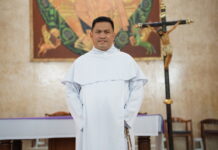FATHER Rolando V. de la Rosa, O.P. is set to return to the scene of his greatest personal and professional achievement—the rectorship of UST. But even before he became rector during his first stint in the position in 1990, he had already been an “achiever,” according to Fr. Virgilio Ojoy, OP, a former UST vice rector who was De la Rosa’s companion during his days as a Dominican seminarian and as a postgraduate student in Louvain, Belgium.
During their philosophical studies at the Dominican House of Studies (DHS) and their theological studies in UST, De la Rosa passed his exams with flying colors and collected honors replete with the usual arcane but high-sounding Latin phrases (magna cum laude in theology and summa cum laude in Master’s in Higher Religious Studies).
“His brilliant scholastic achievements prefigured his rise as rector of Asia’s oldest higher education institution,” Ojoy said.
Ojoy entered the DHS at the Santo Domingo Church in Quezon City in 1972. He was a junior to De la Rosa.
As a seminarian, De la Rosa faithfully followed the schedules and rituals of the seminary, said Ojoy, also a former rector of Aquinas University in Legazpi City. “He was diligent, disciplined, and very observant of his duties,” he added.
But De la Rosa was never strait-laced.
Ojoy remembered that De la Rosa was fond of cracking jokes that would “elicit boisterous laughter” from the other seminarians.
His humor indicated his creativity, Ojoy explained. “He was a literary person,” Ojoy said. “He was very good in writing.”
Ojoy added De la Rosa would assist him in editing his manuscripts and papers.
The two seminarians’ writing skills would later find a channel when they joined the UST Varsitarian. De la Rosa entered the paper earlier, becoming editor of Witness, the Church and religious affairs section. Much later, Ojoy would also join the Varsitarian, becoming associate editor.
At DHS, De la Rosa finished AB Philosophy, magna cum laude, in 1977. In 1980, he finished his theology degree, magna cum laude, in UST. He was ordained priest on April 3, 1982.
In 1984, he earned his Licentiate in Sacred Theology, magna cum Laude, and Master of Arts in Higher Religious Studies, summa cum Laude, both from UST.
Armed with a scholarship grant, he went to the Katholieke Universiteit Leuven in Belgium for his postgraduate studies. In 1988, he received from Louvain a civil doctoral degree in Higher Religious Studies and an ecclesiastical doctoral degree in Sacred Theology, both magna cum laude.
Ojoy was also taking up his Master’s in Theology at Louvain at around the same time.
In Belgium, Ojoy recalled how competitive De la Rosa was as a postgraduate student. He noted how serious a student he was as compared to the other international students.
“He sets goals which are reasonably practical, a goal that he knows he can achieve,” Ojoy said about De la Rosa. This goal-setting trait would explain De la Rosa’s later success as UST rector.
De la Rosa would not let anyone distract or hamper him, Ojoy recalled. For example, when he would write a term paper, De la Rosa would faithfully focus on the task and would refuse to entertain visitors or accept invitations to go out with friends.
Coming back to the Philippines after his Louvain studies, De la Rosa was appointed regent of the College of Education, then assistant secretaty general, and much later, full-fledged secretary general.
In 1990, when Fr. Norberto Castillo, another Varsitarian alumnus, ended his term as rector, De la Rosa was elected to replace him.
Ojoy said no one was surprised when De la Rosa, at that time only 37 years old, became rector. It was the same reaction when De la Rosa was hauled back from semi-retirement last September and appointed acting rector after the resignation of Fr. Ernesto Arceo, OP.
Ojoy said it is De la Rosa’s “destiny” to return as UST rector.
Troubled start
But when he became rector in 1990 at a very young age, De la Rosa was not exactly the envy of everyone. UST was facing industrial unrest and De la Rosa had to deal with several labor disputes.
Particularly pressing was the hospital labor dispute.
The Santo Tomas University Employees Association (STUEA) had filed a notice of strike with the labor department, citing unfair labor practice and Collective Bargaining Agreement (CBA) violations by management.
De la Rosa immediately proposed a “living wage” to the employees as set by the National Economic and Development Authority.
According to the Varsitarian’s Nov. 5, 1991 issue, De la Rosa proposed a salary increase of P1,010.29. He also proposed “to continue to upgrade the salaries through a system of promotion and incentives based on work performance and qualification of employees.”
Because of De la Rosa’s timely intervention, a strike was prevented and industrial peace prevailed in the hospital and on campus.
Academic and research excellence
De la Rosa then focused on his pet projects: fostering excellence in UST’s curricular programs and cultivating a culture of research among the faculty.
As if to emphasize research, De la Rosa had the Central Library Bldg. constructed. He also renovated the UST Archives so as to better service researchers and historians. It was also during his time that the groundwork was laid for the setting up of the Thomas Aquinas Research Complex, which was envisioned to house all of UST’s research centers in the natural and social sciences.
UST’s pre-eminent status as the country’s foremost Catholic university was cemented when several of its programs were declared centers of excellence and development by the Commission on Higher Education.
Declared centers of excellence were Medicine, Pharmacy, Chemistry, Nursing, Electronic and Communications Engineering, Accountancy, Physical Therapy, Music, Architecture, Literature and Philosophy. Declared centers of development were Biology, Business Administration, and Engineering programs.
It was also during De le Rosa’s time that it enjoyed a deregulated status.
“It was a big help to the University to be considered as a deregulated school. In the first place, it somehow occasioned a self-examination whether we are worthy of such status. We also learned to pinpoint those areas in the University that needed to be improved if we want to maintain that status in the future,” De la Rosa was quoted as saying.
Student services
Perhaps because of De la Rosa’s youth, students warmed up to him. It helped that De la Rosa as a priest had a pastoral spirit that made him easily reach out and relate to the students.
It was along this spirit that De la Rosa established the Office of the Campus Ministry in 1990. The Center was tasked to organize retreats and recollections for the students, the better to deepen their spirituality and bind together the campus.
Knowing fully well that the language of the media had become the language of the youth, De la Rosa also established the Educational Technology Center (EdTech), which produces educational media that could aid in classroom instruction.
The EdTech had a television studio where programs could be produced and aired.
The center also had an editing and production room with cutting-edge equipment (video cassette player, an editing controller, a digital video-audio-visual mixer, three color monitors, one multi laser disc player, an audio-mixer and a special effects generator).
The center’s preview room was equipped with four 21-inch color monitors, two videocassette players, and two omni-vision players.
EdTech also had a radio room with an audio-mixer, stereo double cassette tape deck, an analog delay machine and a two-channel power amplifier.
UAAP sweep
De la Rosa had personally pledged to work for the unity of the Thomasian community. He was able to achieve this by dealing with industrial unrest and making Thomasians proud about their curricular, research and extra-curricular programs and accomplishments.
De la Rosa’s efforts were boosted in 1993 when after 29 years, the UST Growling Tigers took home the UAAP basketball championship again by sweeping the games without missing a beat or losing a battle.
Because UST won the championship in grand fashion, one newspaper editorial proclaimed, “God is a Thomasian!”
The championship would be repeated three more times. And each time, De la Rosa would be in the midst of the packed crowd, cheering for the Tigers and urging other Thomasians to support them.
The Rector would wear a white shirt embossed with the Tiger image in yellow and black stripes.
“It was an eye-catching scene for Thomasian ringside spectators, what with their number one official spending his vocal chords, executing the now patented UST wave, and clapping his palms numb in a tremendous display of support to the cage team,” the Varsitarian reported in its Nov. 13, 1996 issue.
De la Rosa said he was not conscious about his rooting and the possibility that he was demeaning his position as a result.
“I do not feel any uneasiness doing all those things. After all, I am sure everybody is watching the game. Nobody is watching me,” he told the Varsitarian.
Papal visit
Perhaps the high point of De la Rosa’s rectorship came in 1995 when Pope John Paul II visited UST again (the first was in 1981 when the Pope came to Manila to beatify Lorenzo Ruiz and his companion-martyrs, most of them alumni of UST).
The Pope’s 1995 visit was in connection with the 10th World Youth Day which Manila was hosting.
The visit was noteworthy for De la Rosa’s rectorship since the Vatican had originally not wanted the Pope to make a visit again of UST, a pontifical university.
This was because another university—a Jesuit institution–had been initially chosen to host the International Youth Forum (IYF), the “United Nations” conference of young people from around the world which was a highlight of the World Youth Day. The school that would host the IYF would be the school that the Pope would visit.
De la Rosa showed again his competitive spirit by making moves to have the Vatican decision not to award UST the right to host IYF reconsidered. In the campaign, he enlisted the support of no less than Cardinal Jaime Sin, the powerful archbishop of Manila.
But since the Vatican representative arranging the Pope’s visit was a Jesuit, the campaign seemed a long shot.
And in fact, when the Vatican representative came, UST was not part of his itinerary since it had apparently been already decided that the IYF would be hosted by the Jesuit institution.
But according to Henrietta de Villa, the lay leader assisting in the Vatican’s preparations, the Vatican representative suddenly found himself being brought to UST apparently on orders of Cardinal Sin.
In UST, De la Rosa and the Thomasian community showered the Vatican representative with hospitality and gently made their case on why UST should be chosen to host the IYF.
Toward the end of the day, the Vatican representative declared: “I am a Jesuit but I choose UST.” Thus, it came to pass that UST became the only Catholic university in this part of the world to have been graced by papal presence not once (Paul VI in 1970), not twice (John Paul II in 1981), but thrice (John Paul II again in 1995).
For De la Rosa, for UST to welcome again John Paul the Great was like “love the second-time around.”
“Holy Father,” he told the Pope at the UST Grandstand before some 200,000 people, “it is said that love is lovelier the second time around. Today, we hope that the love you feel for us Filipinos has doubled in intensity because this is your second visit to the Philippines.”
The Pope thanked De la Rosa for his “kind words of welcome” and added, “As a Pontifical University, Santo Tomas has a special right to the Pope’s attention.”
Outbreak
Perhaps the most severe crisis that affected UST during De la Rosa’s first stint as rector was the hepatitis outbreak in 1997.
After the Christmas vacation in 1996, UST was rocked by the rise of hepatitis cases. From 28 students contracting the virus before the Christmas break, the number jumped to 475 in February 1997.
Investigations by the UST Student Health Service, Department of Health, and Manila Health Department showed that presence of coliform bacilli in the cistern tanks in the High School Building, the Cooperative Canteen, St. Raymund’s Building, and St. Martin de Porres Building.
But the presence of coliform couldn’t explain the outbreak as hepatitis is caused by a different bacterium altogether.
Nevertheless, UST suffered negative publicity, and for De la Rosa, whom close friends said was sensitive to criticism and was conscious always of the need to provide UST a positive public image, the controversy was very painful.
But De la Rosa showed he was up to the crisis. He activated UST’s public information system to assure the public that something was being done to contain the outbreak as well as to check disinformation and black propaganda by the enemies of UST.
Not leaving the victims unattended, De la Rosa offered them assistance, particularly granting them hospital privileges and benefits.
De la Rosa’s administration also closely scrutinized food establishments inside the University.
By March, the outbreak was contained.
No retirement
When he stepped down in 1998, De la Rosa said he wanted to take it easy since “I’ve been working since I was seven years old.”
But it wasn’t meant to be. He was elected prior of the St. Thomas Aquinas Priory, the community of Dominicans based in UST.
In 2003, the then provincial, Fr. Ernesto Arceo, OP, invoked obedience and ordered him to assume the rectorship of Colegio de San Juan de Letran in Calamba. The following year, he was appointed by President Macapagal-Arroyo as chairman of the Commission on Higher Education.
He resigned as CHEd chair in 2005 and rejoined UST, assuming several administrative positions that seemed to presage his comeback as rector of UST.
But by the start of schoolyear 2007-2008, De la Rosa had practically shed all his administrative positions in UST and was happy to be just a regular professor of the UST Ecclesiastical Faculties while earning a reputation as a good retreat master and preacher in several recollections for the diocesan clergy around the country.
De la Rosa had been settling down to semi-retirement when Arceo and the rest of UST’s key leadership resigned last September over the controversy over how best to redevelop and expand the UST Hospital.
The Master of the Order of Preachers, Vatican-based Fr. Jose Carlos Azpiroz, accepted the resignations and looked for a new leadership in UST.
Azpiroz didn’t have to look far. De la Rosa was not only an old hand in the rectorship; he was also a former chair of the CHEd and was respected not only by his Dominican brethren, but also by his peers in the higher education establishment here and abroad.
But where was De la Rosa?
He was in the Visayas ostensibly giving a retreat. Some say he was really there in hiding since he had an inkling he would be drafted again to the rectorship.
But the Dominican Master General’s emissary was able to locate him, and De la Rosa was given the official order—in Latin and invoking obedience—to be rector again of UST even on an acting capacity.
The next month, De la Rosa was elected as a regular rector. Last April, the Vatican’s Sacred Congregation for Catholic Education confirmed his election.
The rest may be history, but for Father Ojoy, the rest is really destiny.
“Yes, it is destiny because there seems to be no one else to lead the Thomasian community,” Ojoy said. “I hope the Rector will plant the seeds for the University to ascend to greater heights.”













